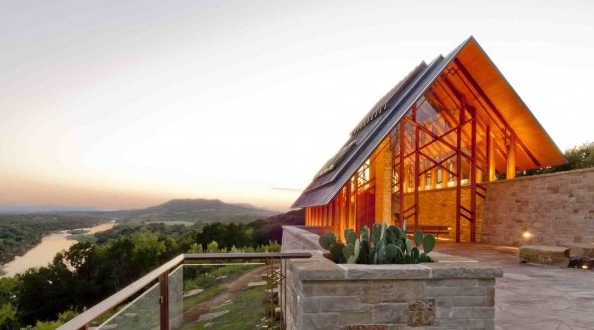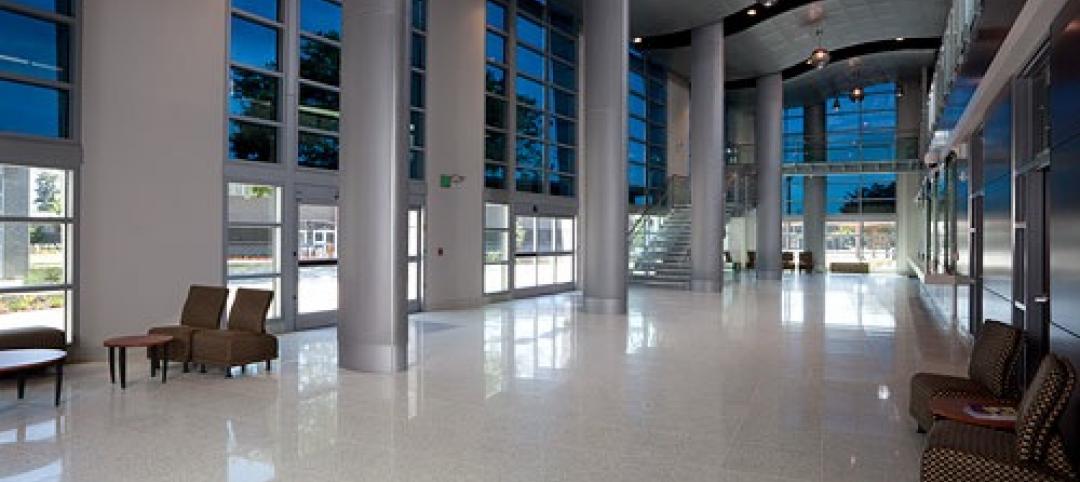From 100-foot roof spans to novel reclaimed wood installations, the winners of the 2013 National Wood Design Awards push the envelope in wood design.
WoodWorks, an initiative of the Wood Products Council, presented the awards at the San Francisco Bay Area Wood Solutions Fair in late January. Winners were recognized across eight categories: commercial wood design; wood design engineering; green building with wood; institutional wood design; interior beauty of wood; multi-story wood design; wood school design; and traditional wood design.
Here's a recap of the eight National Award winners (for more photos, visit www.woodworks.org):
1. Commercial Wood Design Award
LeMay – America’s Car Museum – Tacoma, WA
Large Architecture – Los Angeles, CA

LeMay – America’s Car Museum is a 165,000-square-foot, $60 million structure designed to preserve history and celebrate the world’s automotive culture. The spacious facility houses up to 350 cars, trucks and motorcycles from private owners, corporations, and the LeMay collection.
To create a roof that spans over 100 feet and is more than 300 feet long, the architect initially assumed that steel beams were necessary. But that would have required fireproofing, which was expensive. To keep costs within budget, the roof was converted to a design-build system. Western Wood Structures designed the roof structure using large glulam beams, which were panelized on the ground and erected into place.
The timber roof offered the advantage of Type IV Heavy Construction, which eliminated the need for additional fire protection. The hue of the Douglas fir glulam also created a warm aesthetic, contrasting nicely with the concrete flooring, while coming in at an installed cost of $41.80 per square foot. This created more than $600,000 in project savings.
2. Green Building with Wood Design Award
The David and Lucile Packard Foundation – Los Altos, CA
EHDD – San Francisco, CA

At this 49,000-square-foot company headquarters in Los Altos, California, extensive use of wood emphasizes the building as a healthy and sustainable work environment for the staff. For the exterior in particular, the design reflects California's tradition of wood buildings—underlining the emphasis on indoor-outdoor lifestyle and love for natural materials. This is also referenced in the building layout. The building is centered around a wooded courtyard, with operable doors all around.
The wood adds warmth and a smaller scale to the building with its subtle variations in tone and textural qualities. However, the modern application uses dark reveals to create sub-division and larger scale pattern in the facade, resulting in a taut, crisp and refined skin. The selection of wood as the main exterior cladding material, as well as the interior, was an important strategy for reaching the LEED Platinum rating.
3. Institutional Wood Design Award
Central Oregon Community College Science Center – Bend, OR
Yost Grube Hall Architecture – Portland, OR

The Science Center is a 46,000-square-foot, $12.5 million facility. It includes three general purpose classrooms; dedicated labs for biology, chemistry, geology and physics; herbarium; learning resource center; faculty offices and a wide variety of informal student study areas designed to encourage collaboration and interaction. The campus and region both have a strong tradition of wood buildings, with the surrounding context characterized by structures clad in wood shingles and siding. The Science Center continues this palette with a more contemporary expression, while taking advantage of the deep reservoir of local experience in wood construction. The use of a renewable resource and certified wood products was a primary focus for the design team and owner and helped the project to achieve a Gold rating through the Earth Advantage Commercial program.
4. Multi-Story Wood Design Award
University of Washington West Campus Student Housing – Seattle, WA
Mahlum – Seattle, WA

At the University of Washington, nearly 1,700 beds in three residential halls and two apartment buildings define a new mixed-use campus precinct, which includes a restaurant, grocery store, conference center, cafe, fitness center and academic support center. Employing an exception in the Seattle Building Code, the project team was able to build five stories of light wood-frame construction over two stories of concrete. This allowed the designers to meet the project's ambitious goals within the owner's very tight budget. Using wood as a primary structural material also sped construction times, cut carbon emissions and utilized local materials. Careful attention to detailing created a building envelope that is air and water tight, thermally efficient, and durable. This project represents a paradigm shift at the University and its first embrace of large-scale light wood-frame construction. The buildings are a testament to the fact that wood construction can save resources, time and money, while creating elegant urban structures that contribute to city and campus vitality.
5. Wood School Design Award
Duke School – Durham, NC
DTW Architects & Planners – Durham, NC

The 42,100-square-foot, $5,000,000 project used a combination of glulam and wood-frame structure to give the owner a cost-effective, long-lasting and low-maintenance facility. The use of exposed wood structure and roof decking created a warm and natural educational environment that is greatly appreciated by students, staff and parents. The school site is surrounded by Duke Forest and the highly visible wood interiors were a natural fit for the project. The use of wood was also an important part of the sustainable design strategy for a number of reasons—including a desire to use renewable local materials, wood's contribution to energy efficiency, and the fact that carbon is sequestered in the wood products for the lifetime of the building.
6. Interior Beauty of Wood Design Award
University of Oregon Ford Alumni Center – Eugene, OR
Opsis Architecture – Portland, OR

The Ford Alumni Center is the new gateway to the University of Oregon (UO). The 60,000-square-foot, $28.3 million Center houses the Alumni Association, University Office of Development and the UO Foundation offices, all brought together for the first time in an interconnected, collaborative workplace. No finish material better captures the feeling of Oregon than wood. However, perhaps the most important reason to use wood was that it tells the story of the university. Some of the wood was donated by alumni in the timber and manufacturing industries. The red oak was harvested from a campus tree that fell on the provost's car. The cedar was from a tree that stood for decades in front of the oldest building on campus. The stair treads were reclaimed from a classic Oregon business. And the Douglas fir and Madrone showcase Oregon's homegrown natural resources.
7. Wood Design Engineering Award
Wawona Sculpture – Seattle, WA
Arup Engineers – Seattle, WA

The Wawona Sculpture has a compelling narrative as it connects Seattle's rich timber and maritime history with an inspiring vision for innovation and the future. The sculpture utilized Douglas fir wood planks reclaimed from a recently dismantled Schooner, which was built in 1897 and is now on the National Register of Historic Places. More than 200 4x12 boards were used, totaling approximately 5,000 pounds of wood. The sculpture is 56 feet tall, suspended as a pendulum from the building's roof trusses, kinetic, interactive for the museum patrons to touch and walk through, and built to withstand earthquakes in a region of high seismicity—a significant engineering challenge and a unique example of digital design-to-construction technique. The use of reclaimed wood speaks to its sustainability and longevity as well as long-term carbon sequestration.
8. Traditional Use of Wood Design Award
Rio Roca Chapel – Palo Pinto County, TX
Maurice Jennings + Walter Jennings Architecture – Fayetteville, AR

The Rio Roca Chapel is 1,080 square feet and seats up to 50 people. Southern Yellow Pine was selected for the structural and exterior elements, and the rich, warm color of clear red oak was chosen for the interior. 4x6 Southern Yellow Pine decking provides lateral bracing between the structural bents, and 2x8 pine flitch beams support the roof. The built-in pews are made from clear red oak plywood and solid stock, and the lectern and registry is clear red oak plywood and trim. Most of the wood is exposed, requiring it to not only serve a structural purpose but an aesthetic one. The wood and steel in the project work in conjunction to provide the structure of the building, using each material's strengths for the specific application.
More on the winners at: www.woodworks.org.
Related Stories
| Feb 15, 2012
Code allowance offers retailers and commercial building owners increased energy savings and reduced construction costs
Specifying air curtains as energy-saving, cost-cutting alternatives to vestibules in 3,000-square-foot buildings and larger has been a recent trend among consulting engineers and architects.
| Feb 15, 2012
Englewood Construction announces new projects with Destination Maternity, American Girl
Englewood’s newest project for Wisconsin-based doll retailer American Girl, the company will combine four vacant storefronts into one large 15,000 square-foot retail space for American Girl.
| Feb 14, 2012
Angelo State University opens doors to new recreation center expansion
Designed by SmithGroup, the JJR_Center for Human Performance offers enhanced fitness options, dynamic gathering space.
| Feb 14, 2012
SAIC selected for architectural and engineering design services at Lajes Field, Azores
SAIC’s services will include a broad variety of new construction projects and maintenance and repair projects
| Feb 14, 2012
Skanska promotes Aparicio and hires Leintz in Southern California
Aparicio and Leintz are both based in Skanska’s Los Angeles office.
| Feb 14, 2012
The Jackson Laboratory announces Gilbane Building Co. as program manager for Connecticut facility
Gilbane to manage program for new genomic medicine facility that will create 300 jobs in Connecticut.
| Feb 14, 2012
Thornton Tomasetti names Al Hashimi vice president for its Middle East Operations
Al Hashimi is joining the company to help expand Thornton Tomasetti’s business in the region and support clients locally.
| Feb 13, 2012
WHR Architects renovation of Morristown Memorial Hospital Simon Level 5 awarded LEED Gold
Located in the Simon Building, which serves as the main entrance leading into the Morristown Memorial Hospital campus, the project comprises three patient room wings connected by a centralized nursing station and elevator lobby.
| Feb 13, 2012
Center for Sustainable Building Research launches CommercialWindows.org
Resource aims at reducing commercial operating costs and energy consumption.
| Feb 13, 2012
New medical city unveiled in Abu Dhabi
SOM’s design for the 838-bed, three-million-square foot complex creates a new standard for medical care in the region.

















